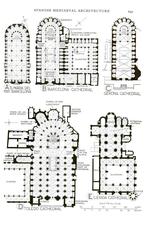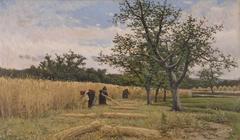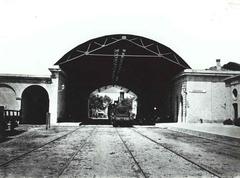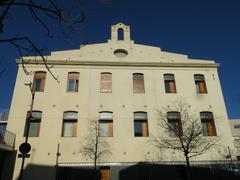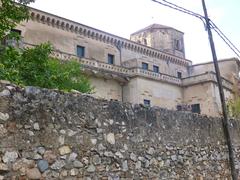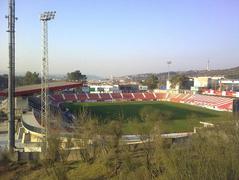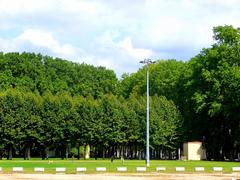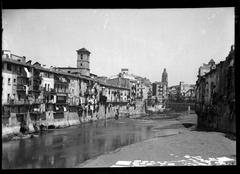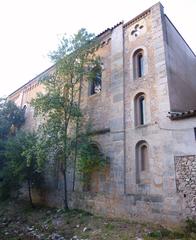
Iglesia de San Félix (Sant Feliu de Girona): The Essential Visitor Guide
Date: 03/07/2025
Introduction
The Iglesia de San Félix, or Sant Feliu de Girona, stands at the threshold of Girona’s historic old town and serves as a powerful symbol of the city’s spiritual, architectural, and cultural legacy. Revered as Girona’s principal place of worship before the construction of its cathedral, Sant Feliu showcases a unique blend of Romanesque, Gothic, and Baroque styles. Its walls have borne witness to centuries of devotion, legendary miracles, and civic pride. This guide offers an in-depth look at the history, artistic treasures, visitor information, and practical tips for exploring one of Catalonia’s most significant historic landmarks.
For further detail and planning, consult Visita Costa Brava, InSpain.org, and Girona Free Tour.
Table of Contents
- Historical Overview
- Religious and Cultural Significance
- Artistic Heritage
- Visiting Information
- FAQs
- Conclusion
Historical Overview
Early Origins and Development
The foundations of Sant Feliu date back to at least 882 CE, with archaeological evidence suggesting an even earlier paleochristian basilica from the 4th century. Originally Girona’s main cathedral, the church is closely tied to the memory of Saint Felix, a 4th-century martyr whose relics have drawn pilgrims for centuries. As Girona grew in strategic and spiritual importance during the Middle Ages, Sant Feliu’s role as a center of worship, community gathering, and local defense became firmly established (Visita Costa Brava).
Architectural Evolution
Romanesque Foundations
The core of Sant Feliu reflects the robust Romanesque style of the 12th and 13th centuries, characterized by thick stone walls, semicircular arches, and fortress-like solidity. The original layout included three naves and a triple apse, designed to welcome large numbers of pilgrims (es.wikipedia.org).
Gothic Transformation
From the 14th to 16th centuries, the church underwent significant Gothic renovations. The soaring nave, ribbed vaults with vibrant medieval polychromy, and the elegant octagonal bell tower (completed in 1368) are standout features. Restoration efforts in recent decades have revealed original painted motifs and colors that enliven the nave and vaults (arteguias.com).
Baroque Enhancements
The imposing Baroque façade and the grand staircase leading to the entrance were added in the 17th and 18th centuries, introducing a theatrical element to the approach. The main portal’s ornamentation and the use of locally quarried stone reflect the era’s artistic trends (spain.info).
Religious and Cultural Significance
Patron Saints and Local Legends
Sant Feliu is dedicated to both Saint Felix and Saint Narcissus. Local tradition tells of Saint Narcissus miraculously saving Girona from invading forces in 1285 when swarms of flies emerged from his tomb to drive out besiegers—a story celebrated in local festivals and iconography (InSpain.org).
The Lioness of Girona
Outside the church stands a replica of “La Lleona,” a 12th-century lioness sculpture. Legend has it that those who “kiss the backside of the lioness” are assured a return to Girona—a ritual popular with both locals and tourists (InSpain.org).
Artistic Heritage
Sarcophagi and Tombs
Sant Feliu houses one of the Iberian Peninsula’s finest collections of early Christian and Roman sarcophagi, dating from the 3rd and 4th centuries. These intricately carved tombs, featuring biblical scenes and symbolic motifs, are a testament to the church’s ancient roots. The Gothic tomb of Saint Narcissus, crafted in the 14th century, is an artistic highlight linked to Girona’s most famous legend (arteguias.com).
Chapels and Altarpieces
The church’s interior is adorned with chapels dedicated to Girona’s saints and benefactors. The Baroque chapel of Saint Narcís gleams with marble and jasper, while the main altar features a richly decorated 16th-century reredos. Other treasures include a Gothic alabaster sculpture of the Recumbent Christ and a Renaissance altarpiece of the Virgin Mary (spain.info).
Visiting Information
Location and Access
- Address: Subida Sant Feliu, 29, 17004 Girona, Spain
- Contact: +34 972 201 407 | [email protected]
- Official website
Located near the Onyar River and the historic city walls, the basilica is easily reached on foot from Girona’s central attractions.
Hours and Tickets
-
Typical Opening Hours: 10:00 – 19:00 (may vary in winter or during religious events)
-
Mass Schedule:
- Daily Mass: 18:30
- Sundays/Feast Days: 12:00 & 18:30
- Vigil Mass: Saturdays, 18:30
-
Admission:
- Entry is generally ticketed; expect €7–€10 for combined Basilica and Cathedral admission (purchase tickets).
- Audio guides are included.
-
Free Admission: Some periods or special occasions may offer free entry; donations are always appreciated (InSpain.org).
Accessibility and Visitor Guidelines
- Accessibility: Main nave and chapels are accessible, but some areas have steps and uneven floors. Contact ahead for detailed support.
- Dress Code: Modest attire is required (cover shoulders and knees).
- Photography: Permitted in most areas without flash; restricted during services or near relics.
- Visitor Conduct: Maintain silence and respect during religious services; observe posted guidelines.
Facilities and Amenities
- Gift Shop: Religious and cultural souvenirs available.
- Restrooms: On-site for visitor use.
- Audio Guides & Tours: Multilingual audio guides included; guided tours available by request.
Getting There
- By Foot: Short walk from Girona’s main historical sites.
- By Public Transport: 15–20 minutes from Girona train/bus stations.
- By Car: Limited historic center parking; public car parks nearby.
Nearby Attractions
- Girona Cathedral (0.06 miles)
- Banys Àrabs (Arab Baths) (0.06 miles)
- Museu d’Història de Girona (0.07 miles)
- Muralles de Girona (City Walls) (0.07 miles)
- Museu d’Art de Girona (0.1 miles)
- Monestir de Sant Pere de Galligants (0.11 miles)
- Museu d’Història dels Jueus (0.12 miles)
(Lonely Planet)
Special Events
The basilica hosts major religious festivities, including Semana Santa (Holy Week), the Feast of Sant Narcís (late October), and local concerts or exhibitions. Check the official agenda for current events.
Frequently Asked Questions (FAQ)
Q: What are the visiting hours?
A: Generally 10:00–19:00 daily. Hours may vary—check the official site before your visit.
Q: How much does admission cost?
A: Standard and combined tickets range from €7–€10. Free entry may be available on special occasions.
Q: Is the basilica accessible for people with disabilities?
A: Accessibility is partial; main areas are accessible, but some chapels and crypts have steps.
Q: Are guided tours available?
A: Yes. Audio guides in multiple languages are included; group tours can be arranged.
Q: Can I take photos inside?
A: Yes, but avoid flash and tripods, and respect any posted restrictions.
Conclusion
The Iglesia de San Félix is a cornerstone of Girona’s heritage—a place where history, legend, art, and faith intertwine. Its Romanesque origins, Gothic grandeur, and Baroque flourishes create an architectural tapestry that rewards careful exploration. The basilica’s treasures, from ancient sarcophagi to legendary rituals, offer visitors a deep connection to Girona’s story.
Plan your visit by checking current hours and ticket options, respecting local customs, and considering a guided tour for richer context. Combine your time at Sant Feliu with nearby historic sites for a comprehensive experience of Girona’s vibrant past and present.
For further planning, visitor updates, and inspiration, consult Catalunya Turisme, Visita Costa Brava, Girona Cathedral ticket portal, and the official Basilica site.
References
- Visita Costa Brava
- InSpain.org
- Girona Free Tour
- Catedral de Girona Official Website
- Catalunya Turisme
- Lonely Planet
- arteguias.com
- es.wikipedia.org
- spain.info
For personalized travel tips, audio guides, and the latest on Girona’s historical sites, download the Audiala app and follow us on social media.


